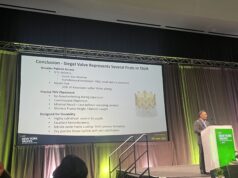
New data presented, by Luca Testa (Department of Cardiology, IRCCS Policlinico S. Donato, Milan, Italy), at EuroPCR (16–19 May, Paris, France) indicates that there is a low rate of clinically relevant bioprosthesis failure nine years after transcatheter aortic valve implantation (TAVI) with a self-expanding device (CoreValve, Medtronic). These data provide reassurance after a study last year suggested that 50% of patients would show signs of valve degeneration after eight years.
Doubt about the durability of TAVI devices, Testa told Cardiovascular News, remains a significant barrier to extending TAVI to lower risk populations. He explains that the “only way” for TAVI to be routinely used in “younger and less sick” patients is for there to be “robust evidence” that TAVI devices are at least as durable as surgical bioprosthetic valves (which, on average, start to degenerate after 10 years), adding that data for TAVI durability are limited at present. “Prior to the study I presented at EuroPCR, the longest published follow-up was five years; this was for patients treated with the Edwards Lifesciences’ Sapien valve (reported by Toggweiler et al in the Journal of American College of Cardiology in 2013). Last year at EuroPCR, Danny Dvir (St Paul’s Hospital, Vancouver, France) presented data for beyond five years for a relatively small population. However, this study has never been published in a peer-reviewed journal,” Testa comments.
Because of this lack of data, Testa and colleagues sought to further examine the issue of TAVI durability by reviewing outcomes from a national-based clinical data repository. They identified 2,343 patients who had undergone TAVI with CoreValve/CoreValve Evolut R (both Medtronic) between June 2007 and December 2016 at 13 Italian centres and found that the longest follow-up was nine years (mean 22 months).
Over the study period, there were 20 prosthesis-related clinical events with an annual incidence ranging from 0.2% to 1.5% (3.2% at the seven-year follow-up point). Of these, six were associated with fatal events: three cases related to endocarditis (at three, six, and 24 months) and three related to severe degeneration of the bioprosthesis (at 26, 72, and 89 months). The remaining 14 events led to a new hospitalisation for heart failure, which included two cases of endocarditis (at nine and 16 months), eight cases requiring valve-in-valve procedures, and two cases requiring medical treatment. Testa told delegates at EuroPCR that “after seven years, up to nine years of follow-up, no further prosthesis related clinical events were recorded.” Additionally, the rates of mild and moderate paravalvular leak did not significantly change between discharge and the last follow-up point. “Our data suggest a very low rate of clinically relevant bioprosthesis failure and provide reassuring evidence about long-term performance,” Testa concluded.
By contrast, Dvir et al found that there was a significant increase in valve degeneration between five and seven years after TAVI. Speaking at EuroPCR 2016, Dvir commented: “We estimate that, according to our preliminary data with early-generation devices [Cribier-Edwards, Sapien, Sapien XT], approximately half of these devices will have degeneration according to the definition we used in our study.” The definition that Dvir and colleagues used did cause some consternation; in a commentary for Cardiovascular News, Michael Reardon (Department of Cardiovascular Surgery, Houston Methodist DeBakey Heart & Vascular Centre, Houston, Texas, USA) said: “Dvir used a rise in mean gradient to over 20mmHg or increase of insufficiency to moderate or above when that was not present at 30 days [to define degeneration]. This is vastly different from what has been used in the surgical literature and one wonders if this very stringent criteria were used for surgical valves what the rate of this new definition of degeneration would be?”
Furthermore, looking at the differences between the Dvir study and his study, Testa said: “Their study did not provide any actuarial estimate of valve dysfunction. In other words, they did not weight the inherent risk of events with the expected survival of the population. The latter is a crucial issue considering that we are dealing with an extremely old population. Moreover, they did not report on the yearly risk of dysfunction but only mentioned the cumulative. Lastly, the study by Dvir and colleagues mainly concerned the balloon-expandable Sapien, which is a completely different device from CoreValve. Whether the differences of the two prostheses could at least partly explain the different results is unclear.”
Given these differences between self-expandable and balloon-expandable devices, Testa says his data cannot be extrapolated to provide an indication of the durability with devices such as Sapien. These data also, he adds, cannot provide information about the durability of next-generation devices. What his study does provide, he notes, is a “first step” towards building the evidence base for TAVI durability.










